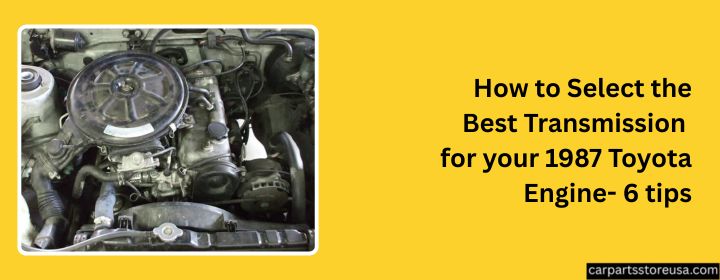
How to Select the Best Transmission for your 1987 Toyota Engine- 6 tips
If you’re working on a 1987 Toyota and you’ve already got the engine part sorted, don’t rush the transmission choice. Getting the wrong one can turn into a serious headache. It’s not just about finding one that bolts up. The whole setup—driveshaft, mount points, shift linkage—has to line up with what your car was built for.
Back then, Toyota had a few engines floating around—22R, 4A-GE, 3S-FE, and others. Each one had specific transmissions that worked best with them. If you’re mixing and matching from different models things can get messy easily. You need to pick smart if you want everything to work right.
This guide is provided by car parts store USA. This is written to help you avoid bad fits and wasted money. These six tips are based on real garage work, not theory. Stick to them, and you’ll avoid the kind of trouble that stalls a project for weeks.
1. Always Start with the Engine Code
- If your Toyota is from 1987, you might be dealing with a 22R, a 4A series, or maybe something else, depending on the model. Before anything else, look for the engine code. Don’t guess. It’s stamped right on the block.
- Once you have that code, find out which transmissions were built to match it. That means actual matches not what “should” work. There’s a big difference. Cars that look the same on the outside may have different drivetrains.
2. Pick Manual or Auto Based on How You Drive
- Think about what you’re doing with the car. If it’s your daily, maybe you want the ease of an automatic. But if it’s a fun project or you’re planning upgrades, go manual. It’s more control and less hassle when you need to push it.
- Toyota made plenty of 4-speed and 5-speed manuals in that era. They’re simple and reliable. Autos were offered too, but swapping between auto and manual isn’t plug-and-play. You’ll need pedals, wiring, and maybe a different driveshaft.
3. Bell-housing Fit Must Be Exact
- The bell-housing is what connects the transmission to the engine. Even if the transmission is from Toyota, it might not bolt upright without the correct bell-housing.
- Some builders try to mix parts and find out later that it doesn’t mate cleanly. Now you’re stuck finding an adapter or a whole different transmission. Avoid that. Buy a transmission that already came off the same engine family, less room for error.
4. Watch Your Mounts and Driveshaft Length
- Not all Toyota transmissions from the late ‘80s are of the same length. If you buy a unit that’s too long or short, the driveshaft won’t fit, and the mounts will be off.
- This matters more than people think. You want that transmission to sit on the factory mount points without bending brackets or cutting anything. Measure everything before you order. Or at least check what vehicle the transmission came from and match that to yours.
5. Don’t Forget the Shifter Location
- It seems like a small thing, but it matters. The shift lever must line up with your center console or floor pan. If it’s too far back or too far forward, you’ll end up with a hole that doesn’t line up or no way to shift.
- Some old Toyota trucks and cars had multiple transmission options that looked the same on the outside, but the shifter was mounted in a different spot. Double check before you commit.
6. Buy From Someone Who Knows What They’re Selling
- Used parts aren’t always clean or tested. That’s the risk. But it’s less of a risk if you buy from a seller that specializes in Toyota parts and knows the differences between engines and transmissions.
- Ask where the transmission came from. Ask if it was tested. If there’s no clear info about mileage, donor vehicle, or condition, skip it. A decent seller should tell you everything upfront—no guessing.
- Also, never buy anything without at least a short warranty. If a seller won’t stand behind their transmission for even 30 days, that’s not someone you want to buy from.
None of these steps are hard. But skipping any of them can cost you time, money, and patience. You don’t want to pull the transmission twice just because you picked the wrong one the first time.
Conclusion
A 1987 Toyota engine is worth keeping if it’s still running strong. These old engines last forever with basic care. But if you’re swapping or rebuilding and need a transmission to match, take your time. Guessing doesn’t work here.
You can either do a thorough research yourself or can choose a trustworthy seller like car parts store USA. They are well known for their transparency and quality customer service. Their massive stock is among top online stores. Take a look at the listings for a 1987 Toyota Engine.
Use the engine code. Get the bell-housing right. Make sure the transmission will bolt up to the mounts and connect to the driveshaft. Check the shift lever location. And only buy from someone who actually knows what they’re selling.
